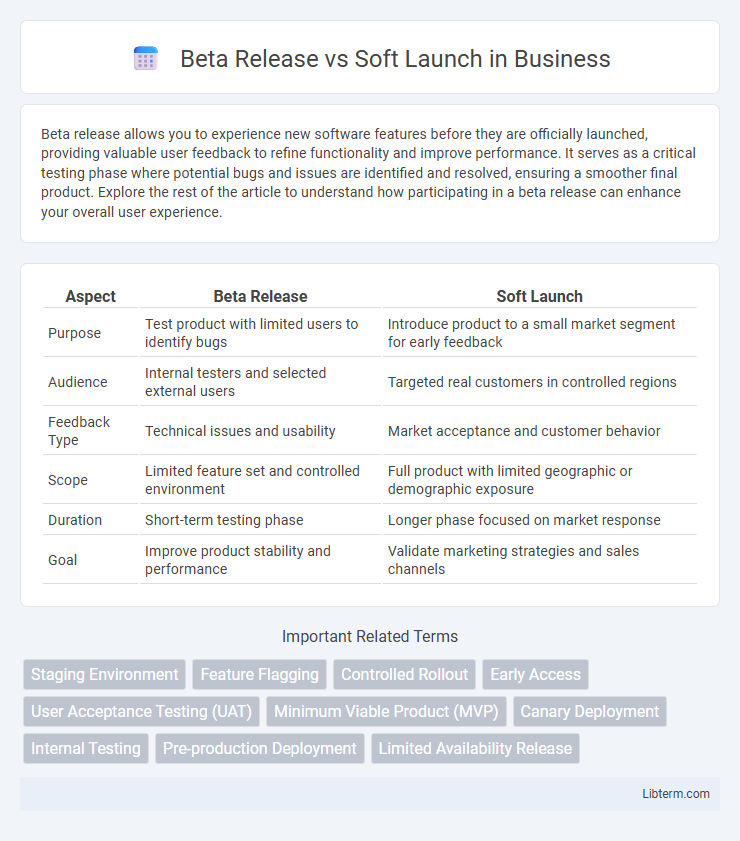Beta release allows you to experience new software features before they are officially launched, providing valuable user feedback to refine functionality and improve performance. It serves as a critical testing phase where potential bugs and issues are identified and resolved, ensuring a smoother final product. Explore the rest of the article to understand how participating in a beta release can enhance your overall user experience.
Table of Comparison
| Aspect | Beta Release | Soft Launch |
|---|---|---|
| Purpose | Test product with limited users to identify bugs | Introduce product to a small market segment for early feedback |
| Audience | Internal testers and selected external users | Targeted real customers in controlled regions |
| Feedback Type | Technical issues and usability | Market acceptance and customer behavior |
| Scope | Limited feature set and controlled environment | Full product with limited geographic or demographic exposure |
| Duration | Short-term testing phase | Longer phase focused on market response |
| Goal | Improve product stability and performance | Validate marketing strategies and sales channels |
Introduction to Beta Release and Soft Launch
A Beta Release involves distributing a near-final version of a product to a limited audience for real-world testing and feedback, ensuring performance and usability improvements before the full launch. In contrast, a Soft Launch targets a smaller, often geographically restricted user base to validate market readiness and gather user engagement data while limiting exposure. Both strategies enable iterative development by uncovering bugs and user experience issues, but the Beta Release emphasizes product functionality, whereas the Soft Launch focuses on market acceptance and operational scalability.
Defining Beta Release: Purpose and Process
Beta release serves as a critical phase in software development aimed at gathering real-world user feedback to identify bugs and improve functionality before the official launch. This process involves releasing a near-final version of the product to a limited audience under controlled conditions to test performance, usability, and compatibility across different environments. The primary purpose of a beta release is to validate product stability and user experience while addressing any issues that were not detected during internal testing.
What is a Soft Launch? Key Features Explained
A soft launch is a strategic product release aimed at a limited audience to gather real user feedback and identify potential issues before a full-scale public launch. Key features of a soft launch include controlled market testing, performance monitoring, and incremental feature rollouts to minimize risks and optimize user experience. This approach allows companies to refine their product based on authentic user behavior and data-driven insights.
Core Differences Between Beta Release and Soft Launch
Beta release involves distributing a product version to a limited audience for real-world testing and feedback, primarily aimed at identifying bugs and improving functionality before the full launch. Soft launch focuses on releasing the product in a restricted market or demographic to assess market response, user engagement, and monetization strategies without extensive feature changes. Core differences include beta release emphasizing technical refinement, while soft launch centers on market validation and performance metrics.
When to Choose Beta Release Over Soft Launch
Choose a Beta Release over a Soft Launch when seeking detailed user feedback and identifying technical issues prior to full-scale deployment, especially within software development or app environments. Beta Releases are ideal for targeting a specific, controlled group of early adopters who can provide in-depth insights on functionality, performance, and bugs. This approach prioritizes iterative improvement based on real user interactions before market-wide availability.
Advantages of Beta Release for Product Development
Beta releases provide crucial real-world user feedback that helps identify bugs and usability issues before full launch. This phase allows developers to test scalability, performance, and compatibility across diverse environments, leading to a more stable and refined product. Early user engagement in a beta release drives feature validation and prioritization, accelerating iterative improvements and reducing post-launch risks.
Benefits of Soft Launch for Market Readiness
Soft launch offers invaluable market readiness benefits by enabling real-world user feedback collection, which helps identify and fix potential issues before full-scale release. This approach minimizes risks by validating product-market fit and gauging user engagement within a controlled environment. Companies can optimize marketing strategies and fine-tune features based on early adoption data, ensuring a more successful and impactful official launch.
Beta Release: Common Challenges and Solutions
Beta release often faces challenges such as limited user feedback, bug identification, and performance issues due to a smaller, less diverse testing group. To overcome these obstacles, employing targeted user segmentation and automated bug tracking tools enhances feedback quality and accelerates issue resolution. Optimizing communication channels and providing clear usage guidelines help increase participant engagement and improve overall product refinement before the full launch.
Soft Launch: Risks and Best Practices
Soft launch allows companies to release a product to a limited audience to test its performance and gather user feedback before a full launch, minimizing risks such as negative reviews or technical failures. Key risks include insufficient user engagement, incomplete data for decision-making, and potential leaks that could harm market positioning. Best practices involve selecting representative test markets, setting clear objectives and metrics, and maintaining open channels for feedback to ensure iterative improvements.
Conclusion: Selecting the Right Strategy for Your Product
Choosing between a beta release and a soft launch depends on your product's development stage and target audience feedback needs. A beta release is ideal for gathering detailed user insights and identifying critical bugs before a full launch, while a soft launch allows market testing with limited users to refine marketing strategies and product positioning. Prioritize beta releases for tech-heavy products requiring extensive testing, and opt for soft launches when validating market fit and demand in specific regions or demographics.
Beta Release Infographic

 libterm.com
libterm.com